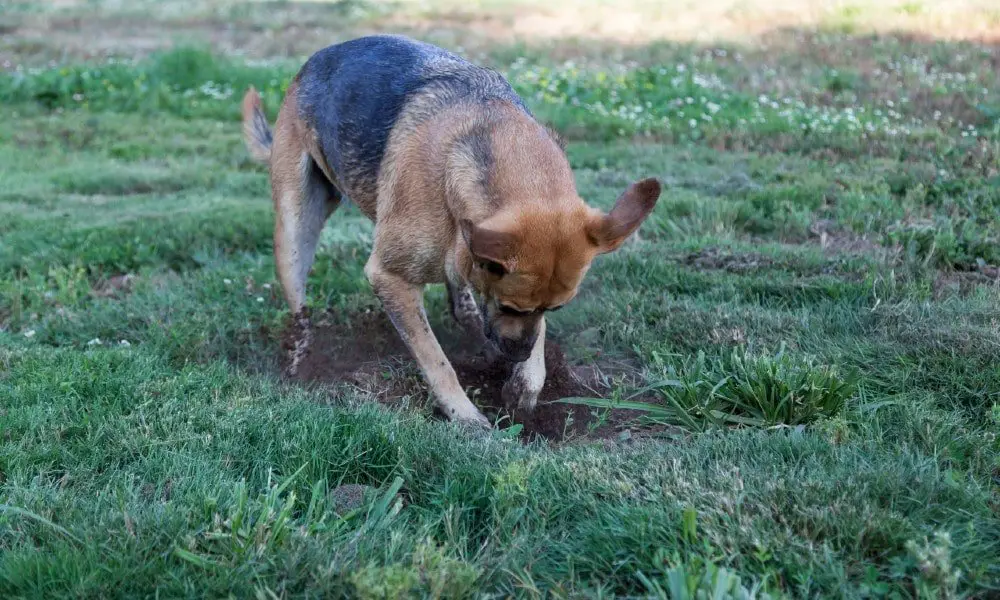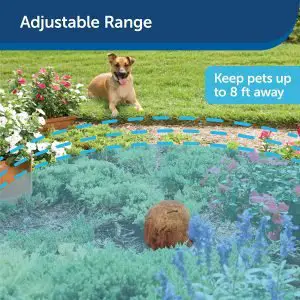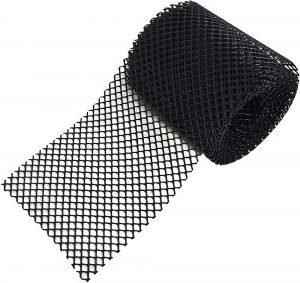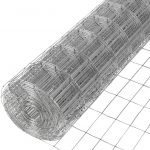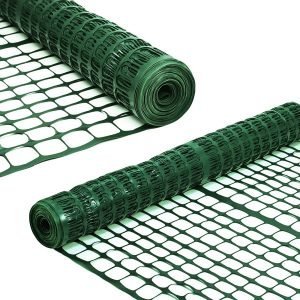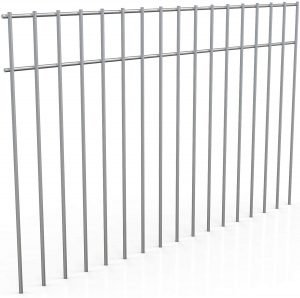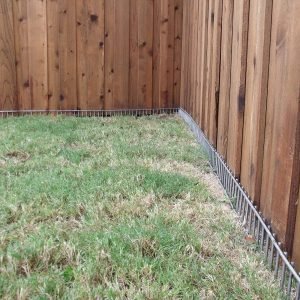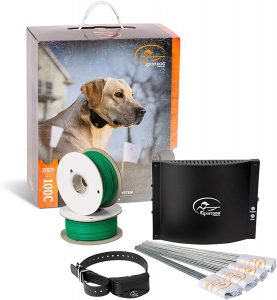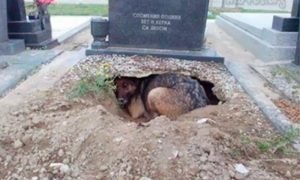Dog digging is natural and instinctive in dogs.
There are many reasons why dogs dig, and there are just as many reasons why owners don’t “dig” their dog, digging holes in the yard and destroying costly landscaping or digging their way to freedom under fences.
Understanding what motivates your dog to dig will assist you in stopping the behavior.
Why Dogs Dig
Boredom – Boredom is the number one reason behind dog digging. Dogs left alone for long periods will find ways to pass the time, and it usually involves destructive methods.
Generic advice to curb boredom is this:
- Exercise your dog before leaving them alone
- Provide toys and chew items to keep them stimulated
These are credible solutions, except they don’t work for extended periods.
For Comfort – If your dog is laying in holes they dug in shady areas or next to buildings, under decks, etc., they are trying to escape the heat on warm days.
The soil below the surface can be 10 to 15 degrees cooler than the current temperature, so it’s understandable why dogs dig to escape the heat.
For Shelter – Dogs dig for comfort in warm weather and dig holes for protection and shelter in cold and stormy weather.
Hiding Prized Possessions – Burying bones, chews, and toys is a survival instinct built into our dogs.
To curb this behavior, It’s most effective if you catch them in the act of burying the possession.
Still, regardless of when you discover the item they are hiding, take it and show them where you are placing it (in the garbage, on a shelf, inside the house, etc.) and fill in the hole in front of them.
Digging for Attention – If your dog feels neglected and learns that digging gets you riled up, attention is attention.
Humans view punishment as negative attention and unfavorable, but it’s better than nothing from our dog’s perspective.
Digging to Escape – Dogs dig to escape their yards to get to something or to get away from something.
Simple boredom and lack of stimulation are one reason. The lure and excitement of other dogs, cats, or critters are another.
Females in heat may try to escape to find a suitor, and unneutered males who smell a female in heat will go to great lengths to get to her.
Dogs frightened by loud noises such as sirens, thunder, fireworks, etc., will dig out of yards and take off running and keep running to try and get away from the noise.
Dogs that suffer from separation anxiety dig out of yards to relieve stress and look for you.
Digging for Prey – Most dogs are hard-wired with prey drive. Some breeds and dogs have more prey drive than others.
Breeds like terriers were specifically bred to dig, flush out and capture creatures like gophers, moles, voles, and groundhogs who tunnel beneath the ground.
How do you determine your dog is digging for a rodent? Your dog will frantically dig in a specific location, then stop and wait. When your dog hears, sees, or senses movement in the ground, the digging will start back up.
To eliminate this digging problem, eliminate the critter causing havoc.
Puppies Are on the Way – If your momma is digging holes in your yard, pay attention because puppies will be arriving soon.
When left to her own devices, a female dog about to give birth will instinctively seek a safe place to protect and shelter her newborn puppies.
In the wild, birthing puppies in a hole would protect them from predators.
Eliminate this problem by confining your female in a secure and comfortable area and have a whelping box set up and ready to go.
Copycat Digging – Your dog watches you dig and plant in the yard and thinks it’s okay for them to dig too. From your dog’s perspective, it seems only fair.
Newly planted items and uprooted soil have an aroma that is hard for dogs to resist. Loose soil is also soft and fun for dogs to dig in.
Expect your dog to be tempted in this situation and be prepared to stop it before it starts.
Train Your Dog Not to Dig
Two commands are needed to teach your dog not to dig.
- A solid down command from a distance
- The leave it command
Down Command – When you catch your dog in the act of digging, give the down command. Being placed in a down stops the action and is a buzz kill, in your dog’s opinion.
Next, remove your dog from where they were digging. Put your dog on a down-stay in another area of the yard or take them inside.
Think of this scenario as a time-out. Your dog’s fun and freedom have been halted. If digging results in consistent time-outs, most dogs will want to avoid this form of punishment and change their behavior.
Leave It Command – The down command is reacting after your dog has started to dig, and the leave it command is for stopping your dog before they dig.
When you see your dog sniffing around an area, or you sense they are about to get into mischief, give the leave-it command.
Click here for 3 Simple Steps to Teach the Leave It Command.
A well-trained dog is a solution to stop digging, but there are two problems:
- Training takes time and commitment
- Owners have to be present to catch it happening and stop it
The majority of digging issues occur when owners are distracted or not even home.
Next, let’s look at realistic ways to stop a digging dog quickly.
5 Ways to Stop Dig Digging
Now that we know why dogs dig let’s look at ways to stop it.
1. Make Dog Digging Unpleasant
Most people avoid things that don’t make us physically feel good, and our dogs are no different.
Four items that can make digging an unpleasant experience are:
- Cayenne Red Pepper
- Ground Cover
- Prickly Plants
- Electronic Pet Barrier
Cayenne Red Pepper
Odors can cause digging but can also be used as a digging deterrent.
Cayenne Pepper sprinkled generously in or around a dig zone will irritate your dog’s nostrils when inhaled. Your dog sneezing or rubbing at their snout is a common reaction that is temporary.
Cayenne Red Pepper also works to keep cats from using your flowerbeds as a litterbox.
Multiple applications of pepper may be needed. Stock up with a large container from a warehouse-type retailer like Sam’s Club or Costco, or click here to order from Amazon
If Cayenne Pepper doesn’t work on your pooch, here are some other items to try:
- Black Pepper
- Tabasco
- Coffee Grounds
- Anit-Chew Sprays
- White Vinegar
Ground Cover
Take a dog to a sandy beach, and they will enthusiastically dig a massive hole to nowhere. Dogs love to to dig in soft, wet sand or soil. These ideal factors are easy to dig in and are easy on their paws.
Effective ground cover to deter digging needs to be dense or coarse. Stay away from pea gravel but here some other ideas:
- Gravel – crushed or other. Put down a generous layer and compact it with a tamper.
- Volcanic Rock
- Concrete Pavers
- Large Wood Chips (Mulch)
Prickly Plants
Ever been scratched a rose or blackberry bush? It doesn’t feel good and leaves a brief reminder on our skin. The same goes for our dogs.
When dogs get pricked by thorny plants, most dogs will avoid future contact with that plant or area.
There a ton of prickly plants to choose from, but you need to do some research. Some plants do better than others, depending on the climate where you live.
Some plants are deadly to dogs. Research any plant that your dog could come in contact with. Whether you are landscaping for decoration or discouraging digging, you need to keep your dog safe.
Electronic Pet Barrier
For around a hundred bucks, the PetSafe Pawz Away Barrier will keep your dog out of its favorite digging spots.
The transmitter is waterproof and designed as a rock to blend into landscaping.
The transmitter creates a wireless boundary up to 16 feet or can be upgraded to an additional 150 feet of the boundary wire.
The transmitter sends a tone, then a safe static reminder to the waterproof collar to remind your dog to stay away from the designated area.
Additional collars can be purchased for multi-dog houses.
Check it out here
2. Install a Digging Barrier
If you have tried to make digging unpleasant with ground cover and failed with any of the above tactics, it might be time to up your game with a digging barrier.
Purchase chicken wire, roll it out, tack it down, and place your ground cover on top of it. The chicken wire provides a rough barrier between soil and paws.
Chicken wire is easy to find and can be purchased at most large home improvement stores, hardware stores, and feed supply stores.
The drawback to chicken wire is rust over time and sharp edges that could cut paw pads.
A better solution to metal is a plastic chicken wire mesh that you can find here
3. Install Fencing
If your dog targets a specific area of your yard like flower beds or garden areas, some t-posts, zip-ties, and galvanized fencing is an affordable do-it-yourself project.
For a less permanent solution, plastic mesh fencing might suit your needs.
4. How to Stop Digging Under Fence
If you have a dog digging at your fence line, this is a safety issue that requires immediate attention.
To prevent your dog from digging under your fence and escaping your yard, here are several solutions:
- Digging Barrier
- Invisible Fence
Dog Digging Barrier
Steel digging barriers go into the ground to at fence lines to stop dogs digging and other creatures tunneling into unwanted areas.
Steel digging barriers are simple to install, don’t look too bad, and can also be used to block gaps in fencing or decking.
Check it out Dig Defense here
Invisible Fence
Invisible fencing is a lifesaver for owners who live in large open areas where standard fencing is not practical.
If your dog is determined to dig its way out of your yard, invisible fencing can be installed discreetly in front of your physical fence to halt the behavior very quickly.
The concept of an invisible fence is a transmitter, wire, and collar worn on your dog.
The SportDOG In-Ground Fence System can cover 1 to 100 acres and contain multiple dogs with additional collars.
Check out SportDOG here
5. Confinement
The last suggestion to stop your dog from digging is confining them to an outdoor kennel.
A kennel should not be used as a full-time solution but as a way to keep your dog and yard safe while you are at work or gone for short durations throughout the day.
Be sure the kennel has shade for warm weather and a protected area (crate or dog house) for wet and cold weather.
A cyclone cover or lid on top of the kennel is recommended to prevent determined dogs from climbing out.
Do not place the kennel on grass or soil because a bored dog will perform the behavior you want to eliminate, which is digging.
If concrete isn’t available to place the kennel on, stone pavers are an option, or horse mats sold at Tractor Supply stores or feed stores.
Always be sure to provide your dog access to fresh water and toys for mental stimulation.
Conclusion
Now that you understand all of the many reasons dogs dig, you need to determine why your dog is digging so you can stop the behavior permanently.
The next step is to pick any of the solutions listed in this article and get started.
Not every method will work for every owner or on every dog. The key is to find a solution you are comfortable with, be more stubborn than your dog, and not give up.
If one method fails, try another until you have curbed your dog’s desire to dig.

